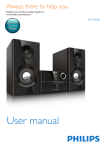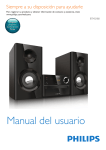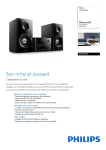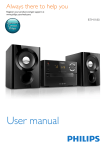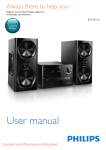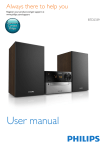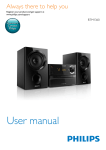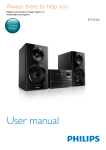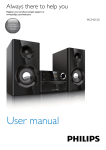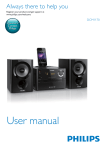Download Philips BTM2180
Transcript
Always there to help you Register your product and get support at www.philips.com/welcome BTM2180 Question? Contact Philips User manual Contents 1Important 3 Safety3 2 Your micro system 5 Introduction5 What's in the box 5 Overview of the main unit 6 Overview of the remote control 7 3 Get started Connect speakers Connect power Demonstrate the features Prepare the remote control Set clock Turn on 5 Listen to the radio 13 6 Other features 14 Set the alarm timer Set the sleep timer Listen to an external device 8Troubleshooting 17 9Notice 19 15 16 16 8 8 8 9 9 9 10 Tune to a radio station Program radio stations automatically Program radio stations manually Select a preset radio station 15 Specifications USB playability information Supported MP3 disc formats 8 4Play Play from disc Play from USB Control play Skip to a track Program tracks Play from Bluetooth-enabled devices 7 Product information 10 10 10 11 11 11 13 13 13 13 14 14 14 EN 2 1Important Safety This 'bolt of lightning' indicates uninsulated material within the device may cause an electrical shock. For the safety of everyone in your household, please do not remove the covering. The 'exclamation mark' calls attention to features for which you should read the enclosed literature closely to prevent operating and maintenance problems. WARNING: To reduce the risk of fire or electric shock, the device should not be exposed to rain or moisture and objects filled with liquids, such as vases, should not be placed on the device. CAUTION: To prevent electric shock, fully insert the plug. (For regions with polarized plugs: To prevent electric shock, match wide blade to wide slot.) Important Safety Instructions a Read these instructions. h Do not install near any heat sources such as radiators, heat registers, stoves, or other apparatus (including amplifiers) that produce heat. i Do not defeat the safety purpose of the polarized or grounding-type plug. A polarized plug has two blades with one wider than the other. A grounding type plug has two blades and a third grounding prong. The wide blade or the third prong are provided for your safety. If the provided plug does not fit into your outlet, consult an electrician for replacement of the obsolete outlet. j Protect the power cord from being walked on or pinched, particularly at plugs, convenience receptacles, and the point where they exit from the apparatus. k Only use attachments/accessories specified by the manufacturer. l Use only with the cart, stand, tripod, bracket, or table specified by the manufacturer or sold with the apparatus. When a cart is used, use caution when moving the cart/apparatus combination to avoid injury from tip-over. b Keep these instructions. c Heed all warnings. d Follow all instructions. e Do not use this apparatus near water. f Clean only with dry cloth. g Do not block any ventilation openings. Install in accordance with the manufacturer's instructions. 3 EN m Unplug this apparatus during lightning storms or when unused for long periods of time. n Refer all servicing to qualified service personnel. Servicing is required when the apparatus has been damaged in any way, such as power-supply cord or plug is damaged, liquid has been spilled or objects have fallen into the apparatus, the apparatus has been exposed to rain or moisture, does not operate normally, or has been dropped. Warning •• Never remove the casing of this device. •• Never lubricate any part of this device. •• Never place this device on other electrical equipment. •• Keep this device away from direct sunlight, naked flames or heat. •• Never look into the laser beam inside this device. •• Ensure that you always have easy access to the power cord, plug, or adaptor to disconnect this device from the power. o Battery usage CAUTION – To prevent battery leakage which may result in bodily injury, property damage, or damage to the unit: • Install the battery correctly, + and - as marked on the device. • The battery (packed or installed) shall not be exposed to excessive heat such as sunshine, fire or the like. • Remove the battery when the device is not used for a long time. p Apparatus shall not be exposed to dripping or splashing. q Do not place any sources of danger on the apparatus (e.g. liquid filled objects, lighted candles). r This product may contain lead and mercury. Disposal of these materials may be regulated due to environmental considerations. For disposal or recycling information, please contact your local authorities or the Electronic Industries Alliance: www.eiae.org. s Where the MAINS plug or an appliance coupler is used as the disconnect device, the disconnect device shall remain readily operable. EN 4 2 Your micro system Congratulations on your purchase, and welcome to Philips! To fully benefit from the support that Philips offers, register your product at www.philips.com/welcome. Introduction What's in the box Check and identify the contents of your package: • Main unit • 2 x speakers • Remote control (with one AAA battery) • Short user manual SOURCE VOLUME FM CD AUDIO IN PRESET/ALBUM AUDIO IN With this unit, you can: • enjoy audio from discs, Bluetooth-enabled devices, USB storage devices, or other external devices; • listen to FM radio stations. You can enrich sound output with below sound effect: • Digital Sound Control (DSC) • DSC 1: Balanced • DSC 2: Clear • DSC 3: Powerful • DSC 4: Warm • DSC 5: Bright The unit supports these media formats: 5 EN REPEAT VOL SHUFFLE MUTE DISPLAY SOUND CLOCK PROG TIMER SLEEP SOURCE VOLUME AUDIO IN Overview of the main unit a b c d SOURCE VOLUME i e f l k j h AUDIO IN g a Bluetooth indicator • Show Bluetooth status. b • Turn the unit on or off. • Switch to standby mode or Eco standby mode. c SOURCE • Select a source: CD, USB, FM, AUDIO IN. d Display panel • Show current status. e • Jack for a USB device. f AUDIO IN • Audio input jack (3.5mm) for an external audio device. g Disc compartment h i j • Open/close the disc compartment. • Stop play or erase a program. • • • • / Skip to the previous/next track. Search within a track/disc/USB. Tune to a radio station. Adjust time. k VOLUME +/• Adjust volume. l • Start, pause, or resume play. EN 6 e Overview of the remote control a r b c FM CD AUDIO IN q PRESET/ALBUM d p e REPEAT f VOL g MUTE DISPLAY SOUND CLOCK PROG TIMER h i a SHUFFLE SLEEP o n m l k j / Skip to the previous/next track. Search within a track/disc/USB. Tune to a radio station. Adjust time. f VOL +/• Adjust volume. g MUTE • Mute or restore volume. h SOUND • Enrich sound effect with Digital Sound Control (DSC). i CLOCK • Set the clock. • View clock information. j SLEEP/TIMER • Set sleep timer. • Set alarm timer. k PROG • Program tracks. • Program radio stations. • Auto store FM radio stations. l DISPLAY • Adjust display brightness. • Turn the unit on or off. • switch to standby mode or Eco power standby mode. b CD • Select CD source. c FM/ • Select FM or Bluetooth source. d PRESET/ALBUM / • Select a preset radio station. • Skip to previous/next album. m SHUFFLE • Play tracks randomly. n EN • Stop play or erase a program. o REPEAT • Play a track or all tracks repeatedly. p • Start, pause, or resume play. q USB/AUDIO IN • Select USB or AUDIO IN source. r 7 • • • • • Press to open or close the disc compartment. 3 Get started Connect power Caution Caution •• Use of controls or adjustments or performance of procedures other than herein may result in hazardous radiation exposure or other unsafe operation. Always follow the instructions in this chapter in sequence. If you contact Philips, you will be asked for the model and serial number of this apparatus. The model number and serial number are on the back of the apparatus. Write the numbers here: Model No. __________________________ Serial No. ___________________________ •• Risk of product damage! Ensure that the power supply voltage corresponds to the voltage printed on the back or the underside of the unit. •• Risk of electric shock! When you unplug the AC power cord, always pull the plug from the socket. Never pull the cord. •• Before you connect the AC power cord, ensure that you have completed all other connections. FM SPEAKER OUT (8Ω) ANTENNA 120 V~, 60 Hz AC MAINS~ Connect speakers Note •• For optimal sound, use the supplied speakers only. •• Connect only speakers with impedance that is the same or higher than the supplied speakers. Refer to the Specifications section of this manual. Demonstrate the features In the standby mode, you can demonstrate features by pressing . »» The features are displayed one by one across the display panel. • To turn off the demonstration, press again. SPEAKER OUT (8Ω) FM SPEAKER OUT (8Ω) ANTENNA 120 V~, 60 Hz AC MAINS~ EN 8 Prepare the remote control Caution Tip •• You can view clock information in power-on mode by pressing CLOCK. •• Risk of explosion! Keep batteries away from heat, sunshine or fire. Never discard batteries in fire. •• Risk of decreased battery life! Never mix different brands or types of batteries. •• Risk of product damage! When the remote control is not used for long periods, remove the batteries. To insert the remote control battery: 1 2 3 Open the battery compartment. Insert the supplied AAA battery with correct polarity (+/-) as indicated. Close the battery compartment. Turn on Press . »» The unit switches to the last selected source. Switch to standby mode Press again to switch the unit to standby mode. »» The clock (if set) is displayed on the panel. Switch to ECO standby mode: Press and hold for more than two seconds. »» The display panel is dimmed. Set clock 1 2 3 4 In standby mode, press and hold CLOCK on the remote control for more than two seconds. »» [24H] or [12H] hour format is displayed. Press / to select [24H] or [12H] hour format. press CLOCK to confirm. »» The hour digits are displayed and begin to blink. Repeat steps 2-3 to set hour and minute. Note •• If no button is pressed in 90 seconds, the system exits clock setting mode automatically. 9 EN Note •• The unit switches to Eco Power Standby mode after 15 minutes in standby mode. Switch between standby mode and ECO standby mode: Press and hold for more than two seconds. 4Play Play from USB Note •• Make sure that the USB device contains playable audio content. Play from disc 1 2 3 4 1 Press CD to select the CD source. Press to open the disc compartment. Insert a disc with printed side facing upward. Press USB/AUDIO IN repeatedly to select the USB source. 2 Insert a USB device into the socket. »» Play starts automatically. If not, press . Press to close the disc compartment. »» Play starts automatically. If not, press . FM CD AUDIO IN PRESET/ALBUM USB SOURCE VOLUME REPEAT VOL CD FM CD AUDIO IN SHUFFLE MUTE DISPLAY SOUND CLOCK PRESET/ALBUM AUDIO IN PROG TIMER SOURCE SLEEP VOLUME REPEAT VOL SHUFFLE AUDIO IN MUTE DISPLAY SOUND CLOCK PROG TIMER SLEEP Control play / / REPEAT SHUFFLE VOL +/MUTE SOUND DISPLAY Select a folder. Select an audio file. Pause or resume play. Stop play. Play a track or all tracks repeatedly. Play tracks randomly. Increase or decrease the volume. Mute or restore sound. Enrich sound effect with DSC: balanced, clear, powerful, warm, and bright. Adjust display brightness. EN 10 Skip to a track For CD: Press / to select another track. For MP3 disc and USB: 1 2 Press Press / to select an album or a folder. / to select a track or a file. Program tracks Play from Bluetooth-enabled devices Note •• The effective operation range between the unit and your Bluetooth enabled device is approximately 10 meters (30 feet). •• Any obstacle between the system and the device can reduce the operational range. •• Compatibility with all Bluetooth devices is not guaranteed. You can program a maximum of 20 tracks. 1 2 3 4 5 Press PROG to activate the program mode. For MP3 tracks, press album. / to select an SOURCE VOLUME Press / to select a track, and then press PROG to confirm. AUDIO IN Repeat steps 2-3 to program more tracks. Press to play the programmed tracks. »» During play, [PROG] (program) is displayed. • To erase the program, in the stop position, press . FM CD AUDIO IN PRESET/ALBUM BTM2180 PIN 0000 1 2 11 EN Press FM/ repeatedly to select the Bluetooth source. »» [BT] (Bluetooth) is displayed. »» The Bluetooth indicator flashes blue. On your device that supports Advanced Audio Distribution Profile (A2DP), enable Bluetooth and search for Bluetooth devices that can be paired (refer to the user manual of the device). 3 4 Select 'PHILIPS_BTM2180' on your Bluetooth enabled device and if necessary input '0000' as the paring password. »» After successful pairing and connection, the Bluetooth indicator turns solid blue, and the unit beeps twice. Play audio on the connected device. »» Audio streams from your Bluetooth enabled device to this unit. Tip •• The unit can memorize up to 8 previously connected Bluetooth devices. To disconnect the Bluetooth-enabled device: • Deactivate Bluetooth on your device; or • Move the device beyond the communication range. To clear Bluetooth pairing history: • Pressand hold on the main set for 3 seconds. »» The current Bluetooth connection is disconnected. »» After successful clearing, [CLEAR] (clear) is displayed for 3 seconds. EN 12 5 Listen to the radio Tune to a radio station Tip Program radio stations manually 1 2 3 •• Position the antenna as far as possible from TV, VCR, or other radiation source. •• For optimal reception, fully extend and adjust the position of the antenna. 1 2 3 Press FM/ repeatedly to select the FM source. Press and hold / for more than two seconds. »» The radio tunes to a station with strong reception automatically. Repeat step 2 to tune to more stations. To tune to a weak station: Press / repeatedly until you find optimal reception. Program radio stations automatically Note •• You can program a maximum of 20 preset radio stations (FM). In tuner mode, press and hold PROG for more than two seconds to activate automatic programming. »» All available stations are programmed in the order of waveband reception strength. »» The first programmed radio station is broadcast automatically. 13 EN 4 Tune to a radio station. Press PROG, and then press select a number from 1–20. / to Press PROG to confirm. »» The preset number and the frequency of the preset station are displayed. Repeat steps 2-3 to program more stations. Note •• To overwrite a programmed station, store another station in its place. Select a preset radio station In tuner mode, press number. / to select a preset 6 Other features Set the alarm timer This unit can be used as an alarm clock. You can select CD, FM, or USB as alarm source. Note •• Make sure that you have set the clock correctly. 1 2 3 4 In standby mode, press and hold SLEEP/ TIMER for more than two seconds. »» The hour digits are displayed and begin to blink. Press / Set the sleep timer To set the sleep timer, in turn on mode, press SLEEP/TIMER repeatedly to select a set period of time (in minutes). »» When sleep timer is activated, is displayed. Otherwise, disappears. Listen to an external device You can listen to an external device through this unit with an MP3 link cable. 1 2 repeatedly to set hour. Press SLEEP/TIMER to confirm. »» The minute digits are displayed and begin to blink. Repeat steps 2-3 to set minute, select a source (CD, FM, or USB), and adjust volume. 3 Press USB/AUDIO IN repeatedly to select AUDIO IN source. Connect an MP3 link cable (not supplied) between: • AUDIO IN jack (3.5 mm) on the unit, • and the headphone jack on an external device. Start to play the device (see the device user manual). AUDIO IN FM CD AUDIO IN PRESET/ALBUM REPEAT VOL SHUFFLE MUTE DISPLAY SOUND CLOCK PROG TIMER Note •• If no button is pressed in 90 seconds, the system exits SLEEP SOURCE VOLUME timer setting mode automatically. AUDIO IN To activate or deactivate the alarm timer: Press SLEEP/TIMER repeatedly to activate or deactivate the alarm. »» If timer is activated, is displayed. AUDIO IN Tip •• If CD/USB source is selected, but no disc is placed or no USB connected, the system switches to the tuner source automatically. EN 14 7Product information Note •• Product information is subject to change without prior notice. Specifications Frequency Response Signal to Noise Ratio Total Harmonic Distortion Aux Input USB Direct Version USB 5 V Power 70 W RMS (30% THD) 50 W RMS (10% THD) 60 Hz - 16 kHZ; ±3 dB ≥70 dBA <1% 600 mV RMS Sensitivity 8 ohm 3.5" woofer + 20 mm tweeter >84 dB/m/W Bluetooth Bluetooth version Frequency band Range 15 EN 87.5-108 MHz 50 KHz <22 dBf <45 dBf <30 dBf <3% >45 dBA V2.1 + EDR 2.4GHz ~ 2.48GHz ISM Band 10m (free space) 2.0 full speed ≤500 mA Disc Laser Type Disc Diameter Support Disc Audio DAC Total Harmonic Distortion Frequency Response S/N Ratio Speakers Speaker Impedance Speaker Driver Tuning Range Tuning grid Sensitivity - Mono, 26dB S/N Ratio - Stereo, 46dB S/N Ratio Search Selectivity Total Harmonic Distortion Signal to Noise Ratio USB Amplifier Output Power Tuner (FM) Semiconductor 12 cm/8 cm CD-DA, CD-R, CDRW, MP3-CD 24 Bits/44.1 kHz <1% (1 kHz) 60 Hz - 16 kHZ; ±3 dB >70 dBA General information AC power Operation Power Consumption Eco Standby Power Consumption Dimensions - Main Unit (W x H x D) - Speaker Box (W x H x D) Weight - Main Unit - Speaker Box 120 V~, 60 Hz 30 W <0.5 W 180 x 121 x 239 mm 140 x 260 x 185 mm 1.6 kg 2 x 2.1 kg USB playability information Supported MP3 disc formats Compatible USB devices: • USB flash memory (USB2.0 or USB1.1) • USB flash players (USB2.0 or USB1.1) • memory cards (requires an additional card reader to work with this unit) • • Supported formats: • USB or memory file format: FAT12, FAT16, FAT32 (sector size: 512 bytes) • MP3 bit rate (data rate): 32-320 Kbps and variable bit rate • Directory nesting up to a maximum of 8 levels • Number of albums/ folders: maximum 99 • Number of tracks/titles: maximum 999 • ID3 tag v2.0 or later • File name in Unicode UTF8 (maximum length: 32 bytes) • • • ISO9660, Joliet Maximum title number: 128 (depending on file name length) Maximum album number: 99 Supported sampling frequencies: 32 kHz, 44.1 kHz, 48 kHz Supported Bit-rates: 32~256 (kbps), variable bit rates Unsupported formats: • Empty albums: an empty album is an album that does not contain MP3/ WMA files, and will not be shown in the display. • Unsupported file formats are skipped. For example, word documents (.doc) or MP3 files with extension .dlf are ignored and not played. • WMA, AAC, WAV, PCM audio files • DRM protected WMA files (.wav, .m4a, .m4p, .mp4, .aac) • WMA files in Lossless format EN 16 8Troubleshooting Warning •• Never remove the casing of this device. To keep the warranty valid, never try to repair the system yourself. If you encounter problems when using this device, check the following points before requesting service. If the problem remains unsolved, go to the Philips Web page (www. philips.com/support). When you contact Philips, make sure that the device is nearby and the model number and serial number are available. No power •• Make sure that the AC power cord of the device is connected properly. •• Make sure that there is power at the AC outlet. •• As a power-saving feature, the system switches off automatically 15 minutes after track play reaches the end and no control is operated. No sound or poor sound •• Adjust the volume. •• Check that the speakers are connected correctly. •• Check if the stripped speaker wires are clamped. No response from the unit •• Disconnect and reconnect the AC power plug, then turn on the unit again. •• As a power-saving feature, the system switches off automatically 15 minutes after track play reaches the end and no control is operated. Remote control does not work •• Before you press any function button, first select the correct source with the remote control instead of the main unit. •• Reduce the distance between the remote control and the unit. 17 EN •• •• •• Insert the battery with its polarities (+/– signs) aligned as indicated. Replace the battery. Aim the remote control directly at the sensor on the front of the unit. No disc detected •• Insert a disc. •• Make sure that the disc is inserted with printed side facing upward. •• Wait until the moisture condensation at the lens has cleared. •• Replace or clean the disc. •• Use a finalized CD or correct format disc. Cannot display some files in USB device •• The number of folders or files in the USB device has exceeded a certain limit. This phenomenon is not a malfunction. •• The formats of these files are not supported. USB device not supported •• The USB device is incompatible with the unit. Try another one. Poor radio reception •• Increase the distance between the unit and your TV or VCR. •• Fully extend the FM antenna. Music playback is unavailable on this unit even after successful Bluetooth connection. •• The device cannot be used to play music through this unit wirelessly. The audio quality is poor after connection with a Bluetooth-enabled device. •• The Bluetooth reception is poor. Move the device closer to this unit or remove any obstacle between them. Bluetooth cannot be connected with this unit. •• The device does not support the profiles required for this unit. •• The Bluetooth function of the device is not enabled. Refer to the user manual of the device to find out how to enable the function. •• This unit is not in pairing mode. •• This unit is already connected with another Bluetooth-enabled device. Disconnect that device and then try again. The paired mobile device connects and disconnects constantly. •• The Bluetooth reception is poor. Move the device closer to this unit or remove any obstacle between them. •• Some mobile phones may connect and disconnect constantly when you make or end calls. This does not indicate any malfunction of this unit. •• For some devices, the Bluetooth connection may be deactivated automatically as a power-saving feature. This does not indicate any malfunction of this unit. Timer does not work •• Set the clock correctly. •• Switch on the timer. Clock/timer setting erased •• Power has been interrupted or the power cord has been disconnected. •• Reset the clock/timer. EN 18 9Notice Any changes or modifications made to this device that are not expressly approved by Philips Consumer Lifestyle may void the user’s authority to operate the equipment. This equipment has been tested and found to comply with the limits for a Class B digital device, pursuant to part 15 of the FCC Rules. These limits are designed to provide reasonable protection against harmful interference in a residential installation. This equipment generates, uses, and can radiate radio frequency energy and, if not installed and used in accordance with the instruction manual, may cause harmful interference to radio communications. However, there is no guarantee that interference will not occur in a particular installation. If this equipment does cause harmful interference to radio or television reception, which can be determined by turning the equipment off and on, the user is encouraged to try to correct the interference by one or more of the following measures: • Relocate the receiving antenna. • Increase the separation between equipment and receiver. • Connect the equipment into an outlet on a circuit different from that to which the receiver is connected. • Consult the dealer or an experienced radio/TV technician for help. This digital apparatus does not exceed the Class B limits for radio noise emissions from digital apparatus as set out in the Radio Interference Regulations of the Canadian Department of Communications. This Class B digital apparatus complies with Canadian ICES-003. This device complies with Part 15 of the FCC Rules. Operation is subject to the following two conditions: • This device may not cause harmful interference, and 19 EN • This device must accept any interference received, including interference that may cause undesired operation. Your product is designed and manufactured with high quality materials and components, which can be recycled and reused. Never dispose of your product with other household waste. Please inform yourself about the local rules on the separate collection of electrical and electronic products and batteries. The correct disposal of these products helps prevent potentially negative consequences on the environment and human health. Your product contains batteries, which cannot be disposed of with normal household waste. Please inform yourself about the local rules on separate collection of batteries. The correct disposal of batteries helps prevent potentially negative consequences on the environment and human health. Please visit www.recycle.philips.com for additional information on a recycling center in your area. Environmental information All unnecessary packaging has been omitted. We have tried to make the packaging easy to separate into three materials: cardboard (box), polystyrene foam (buffer) and polyethylene (bags, protective foam sheet.) Your system consists of materials which can be recycled and reused if disassembled by a specialized company. Please observe the local regulations regarding the disposal of packaging materials, exhausted batteries and old equipment. The making of unauthorized copies of copyprotected material, including computer programs, files, broadcasts and sound recordings, may be an infringement of copyrights and constitute a criminal offence. This equipment should not be used for such purposes. The Bluetooth® word mark and logos are registered trademarks owned by Bluetooth SIG, Inc. and any use of such marks by Philips is under license. This apparatus includes this label: Note •• The type plate is located on the back of the device. Specifications are subject to change without notice © 2013 Koninklijke Philips Electronics N.V. All rights reserved. BTM2180_37_UM_V1.0





















